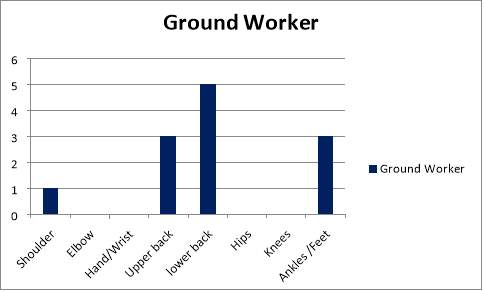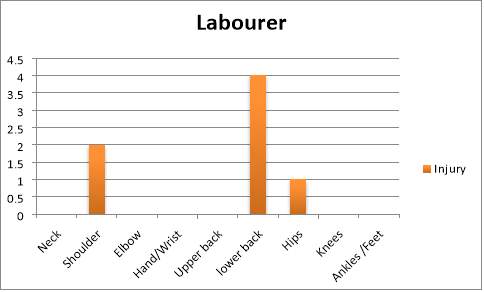Repetitive Strain Injury and Traditional Trades in the Construction Industry
Info: 18263 words (73 pages) Dissertation
Published: 11th Dec 2019
Tagged: ConstructionMedical
Abstract
The Construction Industry can be both rewarding and demanding. For various reasons, it is also synonymous with stress, fatigue and exhaustion activities performed by construction workers. These are usually repetitive and physically demanding.
In the performance of daily work tasks, often with poor posture and awkward working environments, construction personnel can put undue stress on various parts of the body, with the result strain and injuries can arise. Poor working practices can result in fatigue, injuries or in severe cases permanent disabilities. In view of this, the occurrence of workplace injury and disease is increasingly commonplace. Repetitive Strain Injury (RSI) is the most common form of work-related ill-health. Repetitive strain injury (RSI) is a term used to describe various types of injury to muscles, nerves and tendons caused by repetitive movement and overuse. It’s also referred to as work-related upper limb disorder. The condition commonly affects parts of the upper body, such as the: forearms and elbows, wrists and hands neck and shoulders. Musculoskeletal Disorders (MSDs) is another term used to describe conditions affecting the musculoskeletal system the condition can differ in severity from mild and periodic to severe, chronic and debilitating. (Health&Safety Laboratory, 2001)
If personnel are not aware of (RSI) and its symptoms, or they are not recognised and addressed early, long-term and chronic manifestations of the injury can emerge, with the resulting negativity affecting the quality and duration of a persons’ working life. RSI can also have profound implications for companies in terms of potential lost productivity, reductions work quality, and expensive compensation claims with the inevitable increased insurance costs. Companies are compelled the under Health and Safety Legislation Act to provide safe working environments for their employees, and can be held accountable for diseases that have arisen out of and in the course of an individual’s employment, it is therefore essential to train and educate management and workforce in good working practices in an effort to avoid RSI.
There is ongoing international research available concerning workplace injury and disease to inform business and the employees of the dangers and impacts of RSI.
The influence of ergonomic factors in the development of RSI is also a focus of research that may play a role in the prevention and control of RSI. The objectives of this study are to 1) determine the frequency of RSI experienced amongst Irish construction workers
List of Abbreviations
- (CTS) Carpel tunnel syndrome
- (HAVS) Hand Arm Vibration Syndrome
- (LLD) Lower Limb Disorder
- (MSDs) Musculoskeletal disorders
- (RSI) Repetitive Strain Injury
- (T E) Tennis Elbow
- (ULD) Upper limb disorders
- (VWF) Vibration White Finger
- (WRULDs) Work Related Upper Limb Disorders
- (CTD) Cumulative Trauma Disorders
- (OOS). Occupational Overuse Syndromes
CHAPTER 1: INTRODUCTION
Introduction
The range of work activities in the construction industry varies greatly, therefore it is vitally important to have an understanding of each activity in order to identify work tasks where manual handling is a significant part of the work involved. In order to prioritise the manual handling risk assessments that may be required, it is important to have an understanding of the potential risk factors relating to specific tasks. (Health and Safety Authority, 2012)
Modern methods of construction have reduced the requirement for physically demanding tasks, transferring much of the construction programme from an open site to a controlled factory environment, reducing the potential for site-based accidents and ill health. (Taylor, 2009) With all the advances in technology, the construction of buildings still requires a substantial amount of manual labour. “Manual handling-related injuries continue to account for about one third of all non-fatal injuries reported to the Authority. The category ‘all other’ incidents were the second most common accident trigger (31%).”(Health and Safety Authority, 2012)
Repetitive strain injury is also known as work-related upper limb disorder, (WRULD) and is a term used to describe the pain caused to muscles, nerves and tendons. Repetitive strain injury is associated with people doing a particular activity repeatedly or for a long period of time, and can often occur in people whose work involves the use of computers or carrying out repetitive manual work.
A case study published in a HSA report stated “A stonemason was diagnosed with tendonitis (inflamed tendons) in their shoulder, associated with the repetitive nature of their work. Their employer was fined £40,000 (approx. €50,000) because they failed to carry out adequate risk assessments, implement safe systems of work, or provide the employee with adequate rest breaks. This case study highlights the implications of not implementing a simple, practical risk management system for staff who are engaged in work activities which can increase the risk of ULDs.”(Health and Safety Authority, 2012)
RSI (Repetitive Strain Injury) commonly affects different parts of the upper body, such as the, neck, shoulders, forearm, elbow, wrist and hands. Work related upper limb disorders can develop in an occupational setting due to the physical tasks which individuals carry out during their normal work activities. Work patterns such as fixed or constrained body positions and the repetition of movements or force concentrated on small parts of the body, such as the hand or wrist, or the pace of work that do not allow sufficient recovery between movements.
“The construction industry has a long history of higher rates of WRMSDs (Work-related musculoskeletal disorders) due to the physical nature of working in that industry. Plasterers, bricklayers and joiners are the trades frequently cited within construction at high risk” (Health and Safety Executive, 2016)
The objective of this thesis is to examine the prevalence of repetitive strain injury in the construction industry with a specific focus on the traditional trades. It will also examine the various work practices performed by different occupations in the construction industry. It will consider the relationship between workplace ergonomic factors and repetition, static muscle loading, and extreme joint position and the development of muscle, tendon, and nerve entrapment disorders of the upper limbs of exposed workers (known as RSIs).
The main scope of this dissertation is to explore the link between repetitive strain injury and the traditional trades in the construction industry, and the effects it has on the individual
- To explore the relationship of repetitive strain injury and the traditional trades in the construction industry.
- To identify the most common types of repetitive strain injury in the construction industry
- To consider the impact of repetitive strain injury has on the individuals and their ability to carry out their work duties.
- To identify the level of awareness amongst construction workers of RSI and whether there should be more training made available to people.
- To investigate the level of reporting of incidents to the Health and Safety Authority.
- To carry out site visits to observe and discuss the work undertaken by plasterers, carpenters and bricklayers to identify how the work affects the risks of musculoskeletal disorders in these trades.
- Chapter 1: Introduction
This chapter provides an introduction to the document and outlines aims and objectives. It also provides an overview of the contents of the dissertation.
- Chapter 2: Literature Review
This chapter will examine published information from government bodies and various reports on the topic. This includes a comprehensive review of Repetitive Strain Injury and a brief history of when it was first identified.
- Chapter 3: Research Design and Methodology
This chapter provides an explanation of the research methods that were used. It includes a review of primary and secondary data as well as qualitative and quantitative research methods.
- Chapter 4: Data analysis
This chapter analyses the data obtained from the surveys and interviews carried out amongst construction workers.
- Chapter 5: Research Findings
This chapter will present the findings arising from the data and all the information obtained throughout the study.
- Chapter 6: Conclusions and recommendations
This chapter presents the conclusions and recommendations arising from the research.
CHAPTER 2
Literature Review
Introduction
The literature review is an essential stage in conducting research and involves reading and appraising what others have written about the subject. (Naoum, 2007).
It focuses on the incidence of Repetitive Strain Injury (RSI) internationally and evaluating the data regarding its frequency amongst construction workers. This information will be obtained from secondary sources that include publications and reports from government organisations published books, websites, journals and academic reports The DIT library’s online data bases, including info 4 education provides links to The Construction Information Service – CIS and The Occupational Health and Safety Information Service. These provide the majority of sourced material. The review will outline past research in areas and shape the questionnaire design and implementation required to construct this thesis.
Chapter 2.0.1 What Is Repetitive Strain Injury need citation
Repetitive Strain Injury (RSI), Musculoskeletal Disorders (MSDs), and Work Related Upper Limb Disorder (WRULD) are terms used to describe pain felt in muscles, nerves and tendons. The conditions can arise from carrying out tasks for long periods of time without suitable rest breaks resulting in the over use of muscles and tendons in the upper body. In the working environment, various factors have the potential to cause (RSI) e.g. work tasks of a repetitive nature including constant lifting and handling of heavy objects, uncomfortable working postures, sustained or excessive force required to carry out the task over long periods of time. Working environments and poor ergonomics in organisations are also relevant factors. (Health and Safety Executive, 2013)
Chapter 2.1 History of Repetitive Strain Injury
Although seemingly a modern phenomenon, RSIs has long been documented in medical literature, according to (Violante, et al., 2000) the earliest surviving reference describing acute back pain is the Edwin Smith papyrus dating back to 1500 BC. The text describes an incident of chronic back pain which included examination and diagnosis. In 1982 the trade unionist John Matthews first introduced the term repetitive strain injury (Mathews, 1985) which appeared officially in the National Health and Medical Research Council’s Occupational Health Guide: Repetitive strain Injuries. (Sebar, 2007). The Italian physician Bernardino Ramazzini was the first to publish works on the condition. The first edition was printed in Modena in 1700 [Diseases of Workers]. Ramazzini monitored and observed the relationship between occupational hazards and poor health as a student, he observed workers in their working environment.
Ramazzini focused his attention on work related diseases, for nearly 20 years, he investigated the issue in depth. While visiting workplaces he observed workers and their daily tasks, while also discussing their illnesses with them. Bernardino Ramazzini first described over 20 categories of RSI in workers, he also observed the link between many common injures following sustained, strenuous, and irregular physical movements and prolonged postures of the worker’s body. The work Ramazzini carried out in the field of work related illness gave him an expertise on the subject. Based on his observation of workers he established a link between hazard and disease. His study allowed him to link the relationship between workers’ injuries and the exposure to the various environmental working conditions. This enabled him to classify disorders according to the health risk present in each working situation.
Through observation and investigation of workplaces Ramazzini was able to establish a link between hazards and illnesses in the work place allowing him to suggest preventive measures, reducing the negative effects on the individual’s health relating to occupational hazards. Ramazzini described measures to limit the exposure time to hazards as a measure to prevent injuries. Bernardino Ramazzini stated “Therefore in work so taxing moderation would be the best safeguard against these maladies, for men and women alike; for the common maxime “Nothing in excess” is one of which I excessively approve” Bernardino Ramazzini’s contribution to the knowledge of occupational diseases granted him the title of father of Occupational Medicine. (Franco, 1999)
The prevalence of musculoskeletal disorders associated with manual handling Musculoskeletal pain is a prevalent health issue in the working population, according to (Sambyal) repeated manual handling of loads can lead to discomfort, pain or injury to the musculoskeletal system. In particular, back pain is a major work-related health complaint associated with manual handling that occurs across the European Union (EU). A Report by the European Working Conditions Survey carried out by (Eurofound, 2016), states that 32,0% of all people working are exposed to the risk of carrying or moving heavy loads for at least a quarter of their working time. (EU-OSHA, 2017). A report by the (Health and Safety Authority, 2015) states “that about one-third of all reported accidents are the result of manual handling incidents. And every year back injuries top the list of injuries reported to the HSA and under the Occupational Injury Benefit (OIB) scheme” According to (Eurofound, p. 129) jobs involving active manual handling are associated with more risks in the physical environment . Individuals whose work involves active manual handling are exposed to a greater degree of physical risk including.
- Ambient risks (noise, temperature)
- Biological and chemical risks (smoke, infectious materials)
- Posture-related risks (carrying heavy loads, tiring or painful positions).
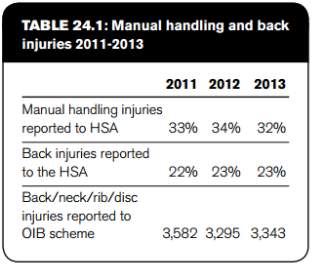 In Canada activities involving manual handling is the greatest cause of occupational fatigue and lower back pain. The (Canadian Centre for Occupational Health & Safety) states that almost 75% of Canadians whose job involves manual handling suffer pain due to back injury at some stage, with repetition contributing to the greatest occurrence of injuries. “Frequently repeated and long-lasting tasks are the most tiring and therefore the most likely to cause back injury”. The Australian construction industry records similar incidents of work related injuries as stated by (Safe Work Austrailia) workers injuries accounted for almost 75% of all serious claims compensated in the industry, between the years 2008-13 over 50% was related to traumatic joint/ligament and muscle/tendon injuries. A report by (Safe Work Australia) states “the cost of work-related injury and disease to workers, their employers and the community for the 2012–12 financial year data is estimated to be $61.8 billion. Injuries account for $28 billion of the total economic cost (45 per cent). The majority of cost is borne by individuals and society”.
In Canada activities involving manual handling is the greatest cause of occupational fatigue and lower back pain. The (Canadian Centre for Occupational Health & Safety) states that almost 75% of Canadians whose job involves manual handling suffer pain due to back injury at some stage, with repetition contributing to the greatest occurrence of injuries. “Frequently repeated and long-lasting tasks are the most tiring and therefore the most likely to cause back injury”. The Australian construction industry records similar incidents of work related injuries as stated by (Safe Work Austrailia) workers injuries accounted for almost 75% of all serious claims compensated in the industry, between the years 2008-13 over 50% was related to traumatic joint/ligament and muscle/tendon injuries. A report by (Safe Work Australia) states “the cost of work-related injury and disease to workers, their employers and the community for the 2012–12 financial year data is estimated to be $61.8 billion. Injuries account for $28 billion of the total economic cost (45 per cent). The majority of cost is borne by individuals and society”.
(Health and Safety Authority, 2015)
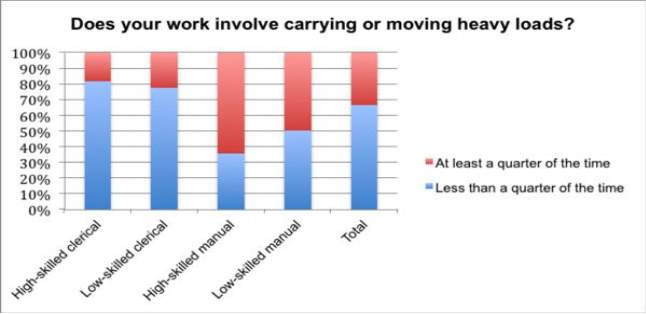
Figure 1 OSH Table on manual handling (EU-OSHA, 2017)
Chapter 3 Work Postures Risk factors
The (Canadian Centre for Occupational Health & Safety) states that a person trying to maintain an awkward position for a long period of time can cause discomfort and fatigue whether in a working environment or not. If an individual’s body reaches the extremes of range and movements, the resulting factor is stretching and compression of tendons and nerves. The longer a fixed or awkward body position is used, the more likely a person is to develop Repetitive Strain Injury. (Safe Work Austraila) States “that musculoskeletal disorders usually develop from exposure to a combination of work-related hazards: for example, working in an awkward posture, and repeating or sustaining muscular actions entailing some degree of force”
Maintaining awkward positions to carry out work tasks contributes to (RSI) e.g. holding the neck and the shoulders in fixed positions, with the muscles in the arm, shoulder and neck contracted for the duration of the task. The U.S. (National Institute for Occupational Safety and Health, 2007) states the risk of developing shoulder pain or a shoulder muscle or joint disorder is increased by the combination of frequently working with raised shoulders (60˚ more), using repetitive arm or shoulder movements while in this position, and applying force while in this position’’. The (Canadian Centre for Occupational Health & Safety) states that when the muscles contract blood flow is restricted, the reduced blood supply accelerates fatigue in the muscles which in turn causes muscle fatigue in the individual with making the individual prone to injury.
Repetitiveness Risk Factors
According to the (Health&Safety Laboratory, 2001) jobs involving repetitive motions of the hand contribute disproportionately to a number of injuries and illnesses and that construction workers were in the occupations most at risk. The ( National Institute for Occupational Safety and Health ) states that “about 37 percent of all lost workday injuries in construction are sprain and strain injuries costing billions of dollars a year”. (Soumitry J & Jochen, 2012) states that in 2005, overexertion when lifting was responsible for 42% of the RSI in construction. (Egronomics Plus) States that repetitive movements are especially hazardous when they involve the repeated movement of the same joints and muscle groups. The physical stress and strain to muscles and tendons can result in microscopic wear to tendons and muscles resulting in fatigue leading to inflammation and discomfort. (Ergonomics Plus). The first signs of RSI can be identified as pain in the fingers or wrists that may include a dull aching pain or sharp stabbing pain. The individual may also experience tingling or numbness, inflammation or joint stiffness, loss of muscle function or weakness and or the extremities of the body turning white or felling cold. (Ergonmics Plus). Detecting the early warning signs will help the individual to take measures through stretching exercises to counteract fatigue and prevent injury from occurring. Check (Ergonmics Plus, n.d.) out for pictures
Chapter 3.1 Psychosocial factors – stress
According to (Wikipedia, 2017) psychosocial refers a person’s relationship between mental and emotional wellbeing and the environment. The (Health and Safety Executive, 2004) state that psychosocial work factors, individual factors and physical factors are areas that have all been implicated in the development of work-related stress. (National Institute of Neurological Discorders and Stroke) States that Pain that becomes chronic also can contribute to the development of such psychological factors. Stress can affect the body in numerous ways, including causing muscle tension. A report conducted by the Health and Safety Executive states that the total number of cases of work related stress, depression or anxiety in 2015/16 was 488,000 cases, with a prevalence rate of 1510 per 100,000 workers. With the total number of working days lost due to this condition in 2015/16 was 11.7 million days. With stress accounted for 37% of all work related ill health cases (Schafeli & Maslach.C) Found that employees who are stressed by their work and become chronically exhausted become demotivated and are inclined to withdraw psychologically from their work. According to the (European Agency for Safety and Health at Work) psychosocial factors refer to an individual’s perception of the effect the environment has on their mental and emotional wellbeing and on their physical and mental health. This relates to the views of the individual in regards the organisation of work, working hours , time off , the culture of the company, the style of management, and the way work is designed, leading to serious deterioration of mental and physical health. According to a (Health&Safety Laboratory) report construction workers accept that injury and working while suffering with injury are part of the job description. And that injured construction workers find alternative ways to perform job tasks while injured. (Hunting, et al., 1999) Argues that construction workers claim that work related injuries have a long term financial and emotional effects on the individual and their families. (Holmstrom, et al.) Also reports that a great degree of stress was reported among 21% of people working in construction, with upper limb disorders linked to levels of psychosomatic and psychosocial incidents in construction workers stress, Poor job satisfaction is also related to increase reporting of injuries and pain in these areas of the body.
Chapter 3.1.1 Job insecurity
The (Trades Union Congress)statesthat new forms of employment contracts may lead the individual to the view that there is less job security, and according to the “proportion of the self-employed are classed as such in order to facilitate lowering costs for their employers, rather than because they genuinely experience the benefits of self-employment, and as such are in ‘bogus’ self-employment, lacking the protections associated with employment”. Job insecurity can lead to increased levels of work-related stress and may have a negative impact on the individuals’ health. (European Agency for Safety and Health at Work). Individuals who suffer adverse health effects in insecure, low paid work, and workers on low earnings and with job insecurity were two and a half times more likely than those in better jobs to develop an illness limiting their capacity to work. (Bartly, et al., 2003)
Chapter 3.1.2 Aging Work Force
According to (European Agency for Safety and Health at Work) ageing workers are more vulnerable to poor working conditions than young workers. The lack of lifelong learning opportunities for older workers, and the increase of mental and emotional demands upon older employees, can result in a negative effect on their health and increase the possibility of work-related accidents.
The (Health and Safety Executive) states that with the work increasing the mental and emotional demands upon older individuals in the work place, employers should look at options regarding physically demanding work and consider, “moving older workers who are experiencing difficulties to tasks that require less heavy physical work may be an option. Reducing heavy lifting and carrying tasks for older workers may help to maintain their health and productivity. It is suggested that older workers in physically demanding jobs could be allowed to use their skills and experience to train younger staff or supervise other”.
Chapter 3.1.3 Work Intensification
(Xanthopoulou, et al.) States that due to increasing workloads, and tasks increasingly being shared between fewer workers, individuals believe they are assessed more upon their efficiency and the results of their work. They tend to work longer working hours to finish their task, resulting in an increase in work related stress. (Sprigg.C.A, et al.) States that strain is an adverse result of stress, creating a need for recovery, which if not addressed may manifest in exhaustion, as well as physical, psychological, or behavioural problems The (European Agency for Safety and Health at Work) states “A growing number of workers state that they experience high levels of pressure stemming from high-speed tasks and/or strict deadlines”.(Felstead, et al., 2012) also concludes that individuals working in an environment where increased job demands such as time pressure, job responsibility, pressure to work overtime, work faster and to tighter deadlines than they did in the past, is likely to increase levels of stress and potential losses of productivity.
Chapter 3.1.4 Poor work–life balance
Work-life balance refers to the flexible working arrangements that allow individuals to avail of working arrangements that provide a balance between work responsibilities and personal responsibilities. (Redmond, et al., 2006). According to the (European Agency for Safety and Health at Work) the association between work and poor work–life balance was also identified as one of the top emerging psychosocial risks and that failure in achieving a decent work–life balance may lead to stress and other negative health effects for workers. The (Health and Safety Executive ) states the primary factors in relation to work related stress depression and anxiety are consistent over time with workload, and poor managerial support and organisational change.
Organisational factors
Companies and organisations can be exposed to hefty compensation claims (Health and Safety Authority) arising as a result of poor working practices, thus greater awareness can contribute to healthier employees but also allow for less exposure to hefty compensation claims. RSI’s place enormous strain on the employee, employer and the economy worldwide as they represent one of the leading health concerns affecting the quality and duration of an employees work life. Awareness of the prevalence of RSI and the relationship with exhaustion and work engagement is vital as a case highlighted in the (Health and Safety Authority) stating that a judge awarded a bank clerk damages of £243,792 (approx. €300,000) after the clerk developed Repetitive Strain Injury (RSI) as a result of working at a poorly designed computer workstation. The bank failed to carry out a suitable risk assessment of the workstation and failed to provide training to the employee. The physical complications associated with the disorder if not dealt with early can have far-reaching effects on not only the day to day physiological functioning and motivation of the individual, but on productivity, absenteeism and early retirement. (The Construction Workers Health Trust)
Risk Assessments Need Citation
The risk assessment process is at the heart of musculoskeletal injury and illness prevention, with effective communication of the risks associated with manual labour the opportunity for targeting and reducing or eliminating RSI in individuals can be achieved. With this in mind the (HSE) developed a method to manage risks from manual handling operations in the workplace, named Manual Handling Assessment Charts (MAC) tool, it identifies high-risk workplace manual handling activities and risk factors for low back pain (LBP). This can equip organisations to encourage earlier detection and recovery by employees, thus providing them with the platform and support to avoid the exacerbation of the symptoms and the development of more chronic forms of the disorder. This knowledge can assist in the design of positive work environments, and promote effort recovery, as well as encourage an improved responsiveness to the emergence of RSI symptoms.
Court Judgments awarded against employers
An article published in the Irish times (Carolan, 2014) records a case taken by an employee of a Dunnes Stores worker who injured her lower back while loading a trolley with heavy boxes. The boxes were stacked above her head and to move them, she had to knock the top box off letting it fall to the ground before placing it in the trolley. While performing these duties she hurt her back. The judge found Ms Meus had not received adequate training to carry out her duties of employment safley and sated “there was also no proper follow up to the training. If this had been the case, Dunnes Stores would have learned Ms Meus was using an incorrect and dangerous method of lifting items. This should have been spotted and corrected, Mr Justice Barr said Ms Meus has fairly constant pain in her back and he awarded €60,000 in general damages”
Improvement in Ergonomics
According to ( Iowa State University ) it is prudent that ergonomic risk factors be considered in the work place considering its relationship and contribution to an RSI. The (National Institute for Occupational Safety and Health, 2007) argues that good ergonomics in the construction industry can help reduce RSI and improve worker’s productivity by reducing the time spent in awkward positions, ergonomics has been around for many years. For example, in 1894 the split-level scaffold was designed for construction workers in the U.S. to reduce construction workers frequent bending. A study carried out by (Vink, 1990) investigated the effect of the placement of bricks and mortar. It showed that raising the stacked bricks to at least 0.3 m from the ground level appeared to lower the energy consumption especially of the individual. The (Health and Safety Authority) also states that training needs to be part of an overall risk management strategy, which is managed and implemented effectively. It argues that there is strong evidence that ergonomic interventions with the involvement of employees and managers and the tailoring of training to suit the individuals and the requirements of the job are effective in reducing manual handling injuries. Another report carried out by the (Health and Safety Executive) finds that financial issues may influence managers not to spend money onergonomics especially if they judge that there will be negligible financial benefit. A Lack of knowledge in the area ofergonomics among many designers means they may be unable to identify the benefits of good ergonomics to their products.
Chapter 2.2 Symptoms of Repetitive Strain Injury (RSI)
Raynaud’s syndrome /Vibration White Finger (VWF)
According to (HCSS) Raynaud’s syndrome is also known as vibration white finger, this injury results from prolonged use of vibrating hand power tools like drills, saws, breakers and other power tools. Raynaud’s syndrome can cause prolonged tingling or numbness in the fingers and hands, even progressing to total loss of sensation in these areas. The problem is often exacerbated in cold temperatures. ( Trades Union Congress) States those individuals who regularly and frequently are exposed to high levels of vibration can suffer permanent injury in the form of vibration white finger. (Health Service Executive) has also recorded that the construction industry has the second highest incidence of vibration white finger, as a result of the over use of handheld power tools, resulting in the tips of the fingers turning white particularly in cold weather.
Carpal tunnel syndrome (CTS)
(National Institute of Neurological Discorders and Stroke) States that carpel tunnel syndrome is a condition that causes pain, numbness and a tingling sensation in the individual’s hand and fingers and is often the result of a combination of factors, including work stress, and repeated use of vibrating hand tools which reduce the available space for the median nerve within the carpal tunnel. The carpal tunnel is a small tunnel that runs from the bottom of the wrist to the lower palm. Tendons that help to move the fingers pass through the carpal tunnel as does the median nerve, which controls sensation and movement of the hand. If there is compression of the median nerve, it can disrupt the nerve signals, affecting the sense of touch and hand movements. (Health Service Executive, 2017)
Tendonitis /Rotator cuff disorders
Tendonitis is connected to the repeated incidence of “micro-tears” to the tendons that connect bone to muscles. The Rotator cuff disorders are usually the result of irritation and inflammation due to overuse of the shoulder. The (Health Service Executive, 2016) states that these conditions may affect someone whose job involves a lot of overhead work which involves activities in which a person is required to reach up and raise one or both arms above the shoulder level on order to carryout work duties. This may also include tilting the person’s head back or to the side to look upwards. If a person is required to perform work tasks in such a posture for an extended period of time or repetitively, or if the task demands exertion of significant force, then it can increase the risk of injuries to neck and shoulder muscle and/or joints. (Soumitry J & Jochen, 2012) In the U.S (HCSS) claims that, “Tendonitis is perhaps the most common injury, and is caused by the repeated incidence of “micro-tears” to the tendons that connect bone to muscles. A type of tendonitis frequently seen in construction workers affects the rotator cuff in the shoulder”. The continued use of the arms in raised positions without frequent rest or adequate conditioning leads to rotator cuff tendonitis. This causes pain and discomfort, as well as stiffness and decreased mobility of the affected joint in some cases.
Tennis Elbow
Tennis elbow is a condition that results in pain around the outside of the elbow and is a result of over use of the forearm creating small tears or minor injury to the forearm. Repeated use of muscles in the wrist can injure tendons in the arm and elbow which lead to tiny tears, in turn causing rough tissue to form on the outside of the elbow. The condition is brought on through carrying out repetitive tasks and actions, such as: manual work that involves repetitive turning or lifting of the wrist, such as plumbing or bricklaying.(Health Service Executive, 2016)
Lower Back pain
According to(National Institute of Neurological Discorders and Stroke) jobs that involves heavy lifting, pushing, or pulling, particularly when it involves twisting or vibrating the spine, and can lead to injury and back pain. In the U.S. a report by (National Institute for Occupational Safety and Health) states that seven out ten construction workers from 13 different trades reported back pain, and nearly a third had sought medical advice.
(Canadian Centre for Occupational Health & Safety) The Complaint may also be caused by a large number of underlying problems of varying physical causes and may include degeneration of the discs between the vertebrae or a spinal disc herniation, The (Health and Safety Authority) states that often the problems that cause back pain are the result of injury and damage to a disc. Pressure on the discs is increased due to bending over and may also cause a disc to bulge backwards towards the spine. Twisting and bending together put the greatest stress on the spine, especially on the discs. A prolapsed or herniated disc is also referred to as a slipped disk; a slipped disk is caused when the jelly-like centre of the disc bulges out. This jelly-like centre may press on a nerve, so trapping it with the result causing pain to the individual. A slipped disc pressing on the sciatic nerve causes sciatica, which can be felt as pain down the leg of the individual. (Health Service Executive, 2006)
Exercise and physical therapy
Exercise and physical therapy aims to increase the individual’s strength, mobility, resilience and capability. Recommendation of specific exercises and engagement in activity offers a less passive approach (as compared to back schools) in that active participation is required. In a comparison of physical therapy, manipulation and the use of an educational booklet for
Chapter 2.1 Repetitive Strain Injury in the U.K
The (Health and Safety Authority, 2012) states that Musculoskeletal disorders MSDs have been cited as the leading cause of work disability in the European Union. The latest the Labour Force Survey (2016) estimates show that in Great Britain, the total number of WRMSDs cases in 2015/16 was 539,000 out of a total of 1,311,000 for all work related illnesses, 41% of the total of all work related ill-health.
It has been estimated that 8.8 million working days were lost due to WRMSDs, an average of 16 days lost for each case. Work related musculoskeletal disorders account for 34% of all working days lost due to work related ill health. (Health and Safety Executive, 2016)
According to Institution of Occupational Safety and Health (IOSH) each year in the UK, some 160,000 people are forced to give up work as a result of long term illness or disability. In 1995/96, work-related illness is estimated to have cost £6.2–7.2 billion. The scale of occupational health problems is massive .In 2001/02 a survey estimated that 2.3 million people in the UK have suffered from an illness that they believed was due to or made worse by their current or past work, accounting for 33 million working days lost. Musculoskeletal disorders were by far the most commonly reported work-related illness, with over 1.1 million people ever employed affected (Institution of Occupational Safety and Health, 2003). The prevalence of work related health issues is extensive. A report in by the ( Health and Safety Executive , 2010) records a survey covering self-reported workplace illness and workplace injury 2009/2010 across Great Britain indicates that 1.3 million people reported illnesses they consider is related to their workplace and of that, the most commonly reported were those suffering from RSI. Of these, an estimated 248 000 (45%) suffered from a disorder mainly affecting their back, 238 000 (42%) from a disorder mainly affecting their upper limbs or neck, and 94 000 (13%) mainly affecting their lower limbs. During this time 23.4 million working days were lost due to injury related to the work place. Of the estimated occurrence of experience of workplace injury in people who worked in 2009/2010, 43% (555 000) of the cases were new.
Chapter 2.2 Repetitive Strain Injury in Europe
In Europe Repetitive Strain Injury is also a major issue with musculoskeletal disorders being the most commonly reported work-related illness, with over 1.1 million people ever employed affected. It is estimated by the European Agency for Safety and Health at Work that around one-third of employees in the EU suffer some form of occupational stress (Institution of Occupational Safety and Health, 2003). A report by the (European Commission, 2017) states that exposure to ergonomic risks factors represents one of the major occupational safety and health problems in the EU today. With repeated exposure to these risks can result in work-related musculoskeletal disorders, one of the most serious and widespread work-related illnesses, which place major cost burdens for individuals, businesses and society in general. A 2013 Labour Force Survey state that work-related musculoskeletal disorders are today the most prevalent type of work-related health issue and the first cause of work-related absenteeism. They represent about 60% of all work-related health problems in the EU, and account for 60% of sickness absences and cases of permanent incapacity to work.
Chapter 2.3 Repetitive Strain Injury in the U.S.
RSI also presents a significant problem within the United States construction industry as Stated in the Construction Chart Book; in 2005 nearly 35% of all nonfatal injuries and illnesses in the construction industry resulting in days away from work were due to sprains and strains. The leading cause of Work-related musculoskeletal disorders among construction workers in the United States is overexertion. In 2005, overexertion while performing heavy lifting tasks caused 42% of the WMSDs with days away from work in construction. Other types of overexertion, such as pushing, pulling, and carrying, caused additional 34% of WMSDs (The Center for Construction Research and Training, 2007).
Chapter 2.4 Repetitive Strain Injury in the Construction industry
The (Health and Safety Executive, 2016) states that people working in the construction industry, skilled tradesmen and machine operatives have statistically significantly greater rates of work related musculoskeletal disorders, with 920 cases per 100,000 workers. According to a (Health&Safety Laboratory, 2001) report, Construction is a high risk industry for musculoskeletal disorders The construction industry has a long history of higher rates of WRMSDs due to the physical nature of working in that industry. Plasterer’s bricklayers and joiners are the trades frequently cited within construction at high risk (Health and Safety Executive, 2016)
Chapter 2.5 Repetitive Strain Injury in the Irish Construction industry
The Irish construction industry also has significant problem with RSI amongst its work force. A survey produced by the Construction Workers Health Trust into the causes of ill health among Irish construction workers found that musculoskeletal disorders were the second most common cause of absenteeism, accounting for 22.8% of days lost. The majority of applications for assistance to the Construction Workers Health Trust benevolent fund, are aged between 45-58, these workers have been medically certified unfit for construction work, and have been granted early retirement or disability allowance. (The Construction Workers Health Trust, 2004)
According to a the Health and Safety Authority publication ‘An Introduction to the Management of Manual Handling in the Construction Sector, up to 1600 injuries from the period 2006–2011 occurred due to a lack of the management of manual handling, accounting for at least 21,000 lost days (Health and Safety Authority, 2013).
A report published by the (The Construction Workers Health Trust, 2004) ‘Patterns of Ill Health Amongst Irish Construction Workers 1997-2004, States that the amount of working days lost due to ill health were 133,268 over that period, Musculoskeletal disorders (MSDs) accounted for 22.8% of absences, back pain accounted for 67% of Musculoskeletal disorders.. According to the recent (Health and Safety Authority , 2011) of workplace injury and illness Statistics 2014–2015, back injury’s accounted for 23%, manual handling accounted for 30%of non-fatal accidents, most injured body parts were broken down as, Back 22%, Shoulder 6%, Arm 6%, Hand 8%, Fingers 10%, Leg 8%, and Ankle 6%. Studies suggest that the introduction of ergonomic improvements in the construction industry may reduce physical load and the incidence of sickness absence (Cowley & Leggett, 2003)
[16]Carpal tunnel syndrome was first identified by the British surgeon James Paget in 1854
Chapter 2.5 Repetitive Strain Injury in other occupations.
A report compiled by the Health and Safety Executive states that the prevalence rates for back disorders are statistically significantly higher in the Construction, Transport and storage and Human health and social work activities compared with the average across all industries. The Transport and storage industries have a rate of 960 cases per 100,000 workers, with 990 cases in the Construction industry, 780 cases in Human health and social work activities and 540 cases across all industries. (Health and Safety Executive, 2016). This report is also backed up by the International Journal of Occupational Medicine and Environmental Health, which states that healthcare workers in direct patient contact are amongst professions with the highest rate of work related musculoskeletal disorders (WMSDs), physical therapists being one of them. The prevalence of WMSDs among physical therapists was high, with lifetime prevalence reported as 55–91%, and 12-month prevalence ranges 40–91.3%, and the lower back as the most frequently affected, with estimates of a lifetime prevalence ranging 26–79.6%. The report also states that tasks involving joint loading, extreme flexion of the trunk, frequent heavy lifting and transferring patients, maintaining an awkward or static posture, bending, twisting, working in the same position for long periods of time and psychological stress, are factors for back injuries in healthcare workers (Milhem, et al., 2016).
Recovery At the workplace,
The (National Institute of Neurological Discorders and Stroke) argues that individuals can do on-the-job conditioning, in the form of stretching exercises to aid recover from injury while also taking regular rest breaks. (Stack, et al.) Also states “It is a good idea to begin work day with some sort of warm-up program. Pre
shift warm-up programs can increase the temperature of the muscles, increase healthy blood flow, and improve muscle coordination. Stretching increases a joint’s ability to move through a greater range motion, therefore, reducing the risk of musculoskeletal injury”. Stretching increases blood flow and improves flexibility, warming up the muscle and making the worker is less likely to suffer from fatigue and discomfort or injury, while improving productivity and increasing the worker’s ability to endure work stress both mental and physical. (Ehs compliance) States that stretching and maintaining the muscle’s pliability and length is important, and allows the body to maintain the proper biomechanical position, and reduces the risk of injury. According to (Occupational Health & Safety) pre-shift stretching and warm-up exercises can help condition the body for the active workday ahead and help reduce work related injuries, stating “an EH&S director for a company that added a stretching component to its WMSD prevention process said that the organization eventually experienced a 30 percent reduction in workplace incident rates after stretching was added.
Under reporting of accidents
(Miller, et al.) States that the reporting of accidents by people is hindered out of fear of it being used to apportion blame, and that less serious injuries make up the majority of unreported incidents, regular under reported injuries included, backs at 37% and soft tissue injuries at 29%.XXX (Mullen, 2004) Also records a worker fearing for her job ensured management did not become aware of the back injury. According to report by the (Health and Safety Executive) only 30% of reportable accidents were reported to the HSE. Occupations in the construction industry had the largest number of reportable accidents, both labouring and trades .Of self-employed workers only (13%) of were reported, employees had only 32% of reportable accidents reported to HSE.
Chapter 3
Research Methodology
Research Methodology
Introduction
Research is a systematic inquiry that investigates hypotheses for the advancement of knowledge, and in order to gain this knowledge the gathering of data and information and its interpretation and analysis is required, a framework is required for the undertaking of the research and the systematic gathering of data and its analysis. Research methodologies vary and are often classified into five categories. As stated by (Naoum, 2007) there are two main of types strategy when it comes to research namely ‘quantitative research, and ‘qualitative research. The purpose of the study and the availability of the information which is required, will dictate which type of research to follow.
Research builds on the knowledge that others have acquired and provides a road map for those who follow. You add to a body of work that will never be complete. Research is an ongoing, collaborative process with no finish line in sight. ( University of California.)
Qualitative research
Qualitative research involves describing in detail specific situations using research tools, like interviews, surveys, and observations. Qualitative research is subjective in nature, it emphasises meanings, experience (often verbally described), description and so on. (Naoum, 2007). Qualitative researchers are more concerned with understanding what is happening as viewed by the participants. ( University of California., 2017)
Quantitative research
Quantitative research requires quantifiable data involving numerical and statistical explanations. Quantitative researchers seek to explain the causes of change primarily through objective measurement and statistical analysis. ( University of California., 2017)This style of research is based on testing a hypothesis or theory composed of variables measured with numbers and evaluated with statistical procedures in order to determine whether the hypothesis or theory can be substantiated. (Naoum, 2007)
Exploratory research
Exploratory research is undertaken when the individual has a limited amount of knowledge about the chosen topic. Exploratory research will provide the researcher with a diagnosis of a situation, screening of alternatives and discovery of new ideas. Preliminary interviews may be utilised to learn of current issues amongst a section of the population. (Naoum, 2007)
Attitudinal research
Attitudinal research is used to subjectively evaluate the view of the person towards a particular object. The term ‘object’ is referred, to as an ‘attribute’ a ‘variable’ a ‘factor’ or a question (Naoum, 2007)
The method of research chosen to conduct this thesis will consist of triangulated studies; this involves using two or more research methods. Both qualitative and quantitative research methods. The qualitative research will consist of open-ended questionnaires, unstructured interviews and unstructured observations. The quantitative research will be used to construct graphs and tables of raw data (Leod, 2008)
Those required to construct this thesis will include case studies, surveys, interviews and questionnaires with individuals or small groups related to the construction industry including professionals and construction workers. (Naoum, 2007) (Leod, 2008)
Secondary Sources will include publications and reports from government organisations, published books, websites, journals and academic reports. These sources will contain the most recent and relevant information on the thesis subject and provide relevant information in relation the findings retrieved from interviews and questionnaires. (Naoum, 2007) (Leod, 2008)
A literature review will be carried out focusing on the key areas of the thesis subject. A large amount of information required will be sourced from publications available online including government bodies such as the Health and Safety Authority and the United Kingdom’s Health and Safety Executive. The DIT library and will also be a source of relevant information in conducting the literary review. The review will outline past research in relevant areas and shape the questionnaire design required to construct this thesis.
3.0 CHAPTER THREE RESEARCH METHODOLOGIES
3.1 SCOPE OF RESEARCH
Chapter Introduction
Research is an inquiry that aims to contribute to a body of knowledge or theory with principles and procedures of logical thought process which are applied to scientific investigation. (Fellows & Liu, 2008) Research is also defined by the Oxford Dictionary “as the systematic investigation into and study of materials and sources to establish facts and reach new conclusions” (Oxford Dictionaries, 2014)
The research methodology is the strategy that outlines the way in which research is to be undertaken. The information gathered is processed enabling the author to gain an understanding and proceed with a method or set of methods that can be applied to calculate the information, which will eventually lead to conclusions. (Wikipedia, 2017) According to (Naoum, 2007) there are two types of research “qualitative research and quantitative research” Researchers may choose qualitative or quantitative methods depending on the subject of the research topic that’s being investigated and the research questions that they are seeking to answer (Wikipedia, 2017)
The largest source of primary data obtained for this thesis has been developed through the use of questionnaires. The research undertaken is predominantly made up of quantitative research questions with a limited amount of qualitative.
The information gathered for this thesis primarily came from secondary sources which included information from books acquired from DIT library, electronic journals, and the internet. With the completion of initial literature review, the basis of many of the questions outlined in the questionnaire was established.
3.2 LITERATURE REVIEW
The secondary data collected for this thesis was sourced from DIT library, including books and electronic journals, which detailed what other authors have written regarding the subject matter and was critically appraised, providing as well as theoretical and methodological a greater deal of understanding towards the problem of Repetitive Strain Injury. Access to the DIT library and the online database proved to be a vital source of information required to carry out the literature review.
Research conducted using the world wide web, in particular information provided on government websites proved to be a major source of valuable information which includes the current knowledge providing substantive findings, contributions to a topics related to Repetitive Strain Injury.
The information collected for this thesis was based on the literature review and aided in the development of the primary research which provided the information obtained to be and compared with previous writings. According to (Naoum, 2007) the most accurate source of information is gained from primary literature, this literature was sourced primarily from the DIT library and its line database amongst others providing academic research journals, theses and government reports journals, newspapers and magazines. All of these sources of literature were used extensively in Chapter Two.
3.3 RESEARCH STRATEGIES
With the completion and appraisal of the literature review, the basis for the research design and methodology was shaped. With this a mixed approach was taken and encompassed both qualitative and quantitative methods, John W. Creswell states that “a mixed methods approach is one in which the researcher tends to base knowledge claims on pragmatic grounds (e.g., consequence-oriented, problem-centred, and pluralistic). It employs strategies of inquiry that involve collecting data either simultaneously or sequentially to best understand research problems”. (Creswell, 2003, p. 18).The information obtained for qualitative research was achieved through open ended interviews, with the information enabling the quantitative research conducted provided via surveys.
Quantitative Research
Quantitative research is defined as an inquiry into social or human problems, based on testing a theory composed of variables, measured with numbers and analysed with statistical procedures, in order to determine whether the hypothesis or theory holds true, (Naoum, 2007) Quantitative data is used where the facts, questions or attributes relative to the research are required or where a relationship between a different set of variables and the facts is needed to test a particular hypothesis. The quantitative research technique is to normally issue a questionnaire offering multiple choice answers. This method of research is objective in approach, in the logic that it only pursues precise measurements and analysis of targeted notions to answer is therefore objective in nature (Naoum, 2007)
Qualitative Research
Qualitative research is subjective. (Fellows & Liu) States “Qualitative approaches seek to gain insights and to understand people’s perceptions of ‘the world” qualitative research emphasises meanings, (often verbally described).Different opinions are often expressed, with the result the researcher has to decipher the information and has to make a judgment on the responses received. This qualitative research involved face to face interviews of three bricklayers that have a combined sixty-two years working experience in the Irish construction industry. The semi-structured interviews were carried out during March and April 2017, and were designed to allow the construction worker’s express freely their experience and perception of RSI and its relationship to working in the construction industry. Qualitative is classified into two categories;
Exploratory Research
Exploratory is conducted when there is a distinct lack of knowledge on the topic. In this situation the interview technique is usually selected as a method of data collection.
Attitudinal Research
Attitudinal researchis employed where the ‘opinions, views or perceptions of a person towards a particular ‘object’ are required. ‘Objects’ include attributes, variables, factors or indeed a question. (Naoum, 2007)
Approach to Data Collection
The primary research was carried out through open ended interviews and use of questionnaires carried out on site in actual working environments. The sites surveyed are all based in the Dublin region, including the Adamstown Housing Development operated by Castlethorn construction, and a number of Momani sites located in Dublin city centre, these surveys were facilitated through the author’s contacts within the industry. The questionnaire was analytical in style, (Naoum, 2007, p. 44) States “the analytical survey aims to establish relationship and association between the attributes/objects of your questionnaire, i.e. how often an attribute is associated with another attribute within the sample questionnaire.” The questionnaire was issued to gather data from a relatively large number of respondents within a short period of time, which included a wide range of construction workers including site managers, tradesmen, scaffolders, and general labours who took part in the survey. A total of 63 workers were surveyed in the Adamstown development and 22 in the smaller Momani sites. This method of distributing the questionnaire was deemed to be the best way of gaining the necessary data and the greatest response rate for the survey, (Holtom & Baruch) States that “The two principal reasons for not responding are failure to deliver the questionnaires to the target population (e.g. wrong address, absent from work) and the reluctance of people to respond the questionnaire”. The questionnaire surveyed a large sample of people in various roles within the construction industry, ranging from site management to general labourers. This provided an environment where interaction with the respondents allowed the author to pose unstructured questions on the topic, providing additional feedback and personal opinions on the subject.
The other source of information obtained for this report was obtained through semi-structured interviews; this form of interview uses ‘open’ and ‘closed-ended’ questions. This type of interview schedule is used and the questions are not asked in a specific order. (Naoum, 2007) The participants in the interviews come from a construction background namely the bricklaying trade, other interviewee has a training and development background, her role includes conducting manual handling courses in her line of work. The first three interviews were conducted face to face in the interviewee’s home, with the last interview conducted over the phone. The information gathered was analysed to.
DATA COLLECTION APPROACHES
The primary research was carried out on site in live working environments, the sites surveyed are all based in the Dublin region, including the Adamstown housing development operated by Castlethorn construction, and a number of Momani sites located in Dublin city centre, these surveys were facilitated through the author’s contacts within the industry. A
Questionnaire was issued which surveyed a wide range of construction workers including site managers, tradesmen, scaffolders, and general labours taking part in the survey. A total of 53 workers were surveyed in the Adamstown development and 23 in the smaller Momani Sites.
3.3.2 Questionnaire Design
The Questionnaires can be either open ended (qualitative), where the individual can answer in full, or closed (quantitative). The questionnaire for this study was a closed quantitative questionnaire, and is based on the subject matter discussed in this thesis (Repetitive Strain Injury) (Naoum, 2007) Stated that ‘whatever questions you need to ask they should not be arbitrary and need to be based on your literature review.’ As such the emphasis of the questions posed arise from issues that have become apparent while completing the Literature Review. The questionnaire is made up of 23 questions and the main emphasis of these questions is based on concerns that have arisen while completing the Literature Review.
These questions included:
- The prevalence of Repetitive Strain Injury among construction workers.
- Awareness of the condition amongst construction workers.
- The relationship with various occupations in the construction workforce.
- The level of reporting of such injuries to the Health and Safety Authority.
- The time periods in which the individuals have been affected
The questionnaire begins with asking if various areas of the body have been affected by injury over a period of time ranging from the past 12 months, to the past 7 days. It also asks whether the respondents believe its related to work activities, and if there has been a negative impact on them outside of work. The purpose of this questioning was to ascertain the various parts of the body affected by injury and to evaluate whether the respondents believed it to be related to work activities. It also seeks to evaluate whether there is a common theme between certain injuries and specific occupations in construction.
CONCLUSION TO RESEARCH METHODOLOGIES
The design questionnaire is directly related back to the dissertation proposal and relating to the aims and objectives and hypothesis of this study.The survey questionnaire is of closed ended, while the interviews conducted were of semi-structured in design. The survey and topic (RSI) was briefly explained to the people taking part in the survey with the comments and feedback from the questionnaire being very positive. The respondents felt it was a worthwhile exercise leaving them with a better understanding and with many only coming across the term Repetitive Strain Injury for the first time.
Chapter 4
Data Analysis
CHAPTER FOUR: QUESTIONNAIRE RESULTS & ANALYSIS
The following chapter details the results and analysis of the responses by 76 individuals to
the survey carried out on Repetitive Strain Injury. The questionnaire contained fourteen questions dealing with issues relating to (RSI) and the different areas of the body affected. The questionnaire is closed but allowed for qualitative comments which will be analysed further into this chapter and the next. The original questionnaire is located in Appendix A.
The Graph below illustrates the range of construction worker’s tradesmen and management that completed the survey totalling to 73 individuals.
The opening of this section of the survey allowed injury affected parts of the body to be identified with various time frames ranging
between 12 months and 7 days ,while also asking about the impacts on time lost due to injury and impacts outside of the working environment.
A complete list of the respondents, their groups, professions and answers can be found in
Appendix B and a full list of the qualitative comments to the questionnaire is illustrated in
Appendix C
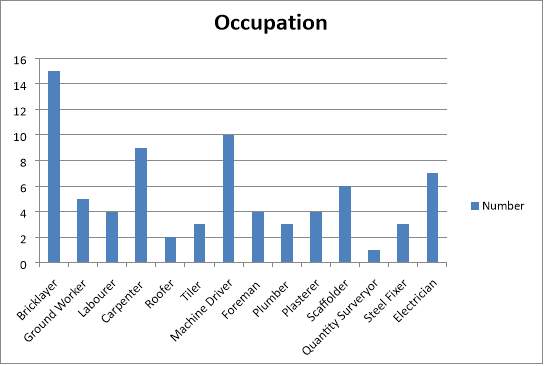
Question No. 1
During the last 12 months have you had an injury problem such as ache, pain, and discomfort in the following areas: Neck, Shoulder, Elbow, Hand/Wrist, Upper Back, Lower Back, Hips, Knees or Ankles/Feet?

The results from the bricklayers indicate that injuries to lower back followed by upper back are common, Shoulder and Elbow also rank high. The lower parts of the body the knees and Ankles/feet are recorded but to a lesser degree.
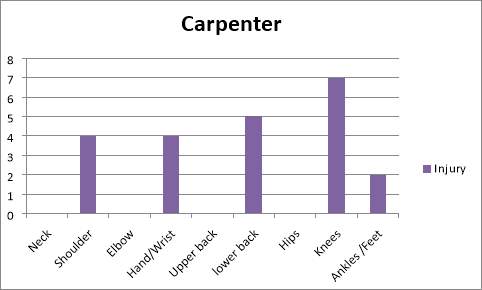
The results from the Carpenters indicate that injuries to the Knees followed by the lower back are common, Shoulder and hand/wrist also rank high, the lower parts of the body the ankles/feet are recorded but to a lesser degree
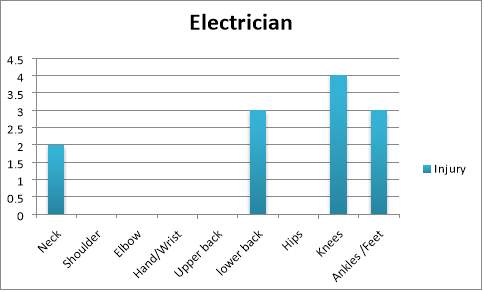 The results from the Electricians surveyed indicate that injuries to the knees totalling 4 out of 7 surveyed, followed by the lower back and ankles/feet are common, neck injury is also recorded but to a lesser degree
The results from the Electricians surveyed indicate that injuries to the knees totalling 4 out of 7 surveyed, followed by the lower back and ankles/feet are common, neck injury is also recorded but to a lesser degree
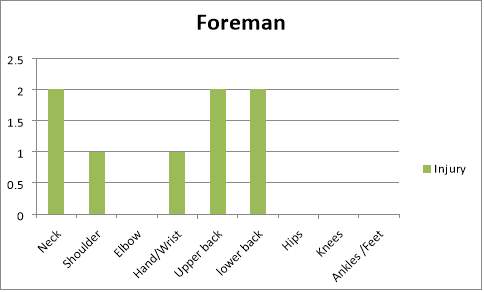
The results out of 4 Foremen surveyed indicate that injuries to the lower back, upper back, and neck are most common, injury to the shoulder, hand/wrist is also recorded to a lesser degree.
The results from the Ground workers surveyed indicate that injuries to the Lower back is most prevalent, followed by the upper back and ankles/feet are common. Shoulder injury is also recorded but to a lesser degree.
The results from the Labourers surveyed indicate that injuries to the Lower back are most prevalent. Followed by the shoulder and while injury to the hips is recorded to a lesser degree.
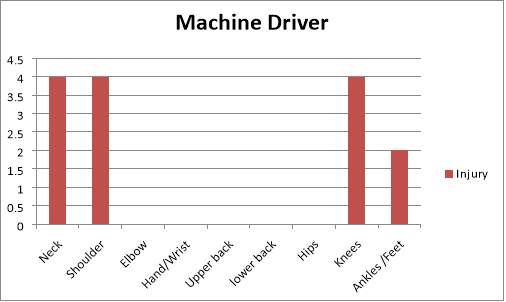
The results from the machine drivers surveyed indicate that injuries to the neck, shoulder, and knees are most prevalent followed by the ankles/feet.
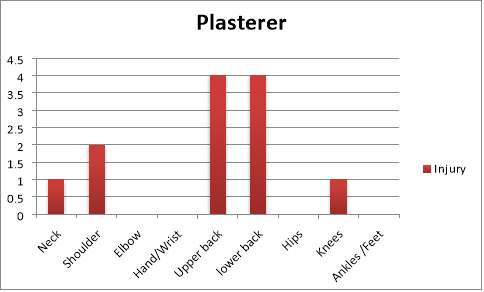
The results from the plasters surveyed indicate that injuries to the upper back, lower back, shoulder, and knees are most prevalent followed by the neck injuries.

The results from the plumbers surveyed indicate that neck, hand/wrist and injuries to knees are the most prevalent injuries.
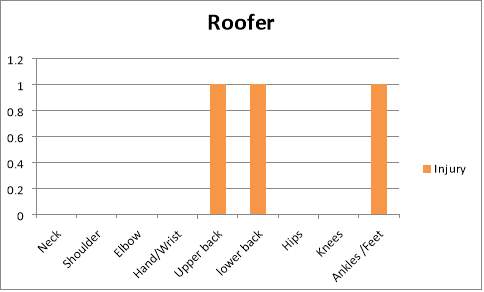
The results from the roofers surveyed indicate that injuries to the upper back, lower back, neck, and ankle/feet are the most prevalent injuries.

The results from the scaffolders surveyed indicate lower back injury is most prevalent while shoulder and upper back injury is also common followed by hip injuries.
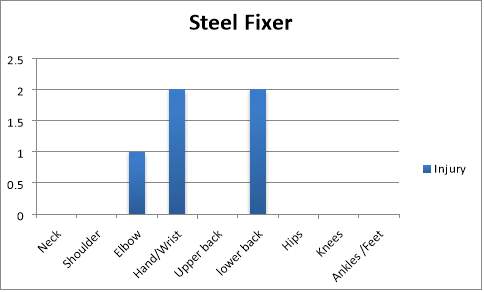
The results from the steel fixers surveyed indicate that lower back, hand/wrist injuries are the most prevalent, followed by elbow injuries.
Recorded injuries of 3 Steel fixers surveyed
The results from the tilers surveyed indicate that shoulder and knee injuries are most prevalent, followed by lower back injuries.
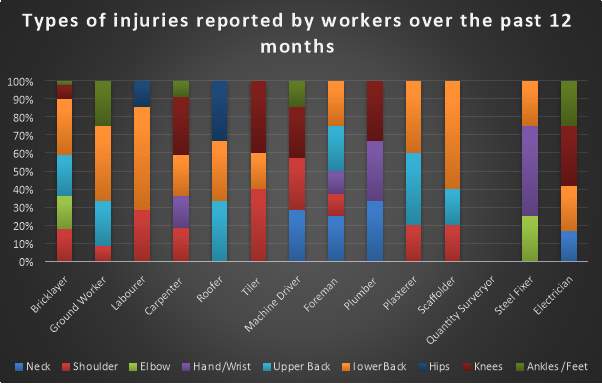
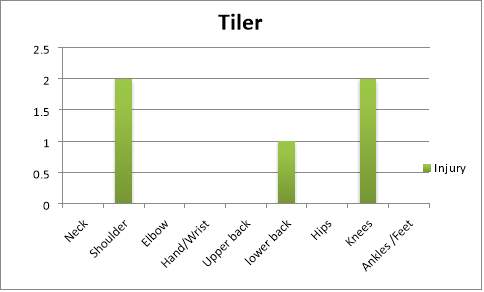
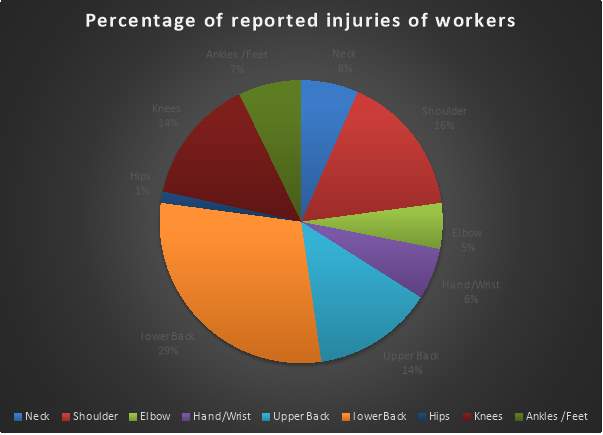
The pie chart above illustrates the most frequently recorded injuries deduced from this survey, with the various injuries broken down into percentages. Viewing this illustration, lower back injury is the highest recorded indecent with 30% of the people surveyed, this is almost twice the number of other injuries including shoulder at 16% upper back and knees at 14%. The third most common injuries include ankles/feet and neck at 7% This is then followed by hand/wrist at 6% and elbow at 5% respectively. Hip injuries are the lowest recorded injury among the workers surveyed.
Question No.2
Have you had this injury problem over the last 7 days?
13% of workers surveyed said they had this injury problem over the last 7 days.
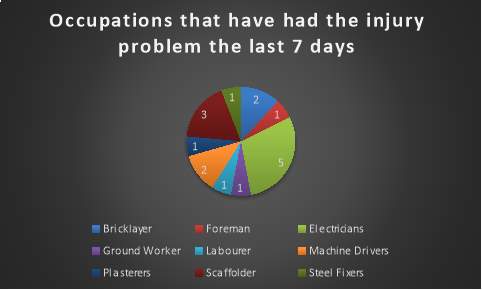
Figure 2
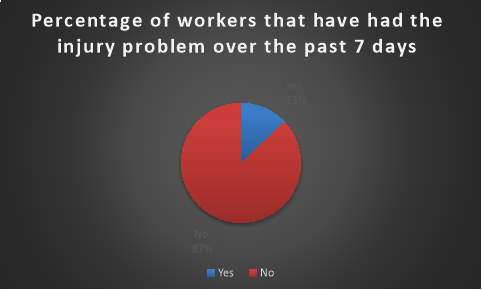
The pie charts above illustrates that 13% of people surveyed said they have experienced injury over the last 7 days. This part of the survey recorded 9 different back grounds displayed in figure noXXXX with 5 electricians recording the highest number followed by 3 scaffolders second.
Question No.3
During the last 12 months has this injury prevented you carrying out other forms of activities e.g. hobbies?
8.% of workers surveyed recorded the injury prevented them from carrying out other forms of activities.
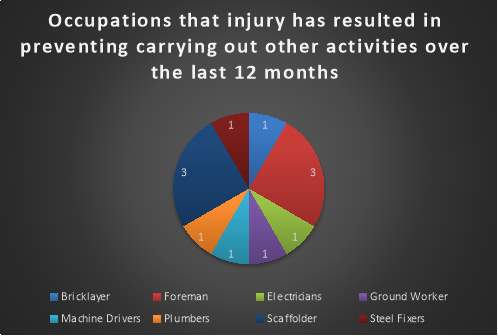
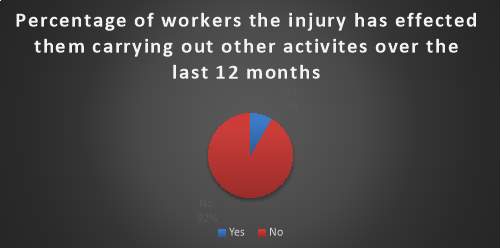
The pie charts above illustrates that 8% of people surveyed said injury has prevented them from carrying out other activities over the last 12 months. This part of the survey records 8 different back grounds with Scaffolders and Foremen recording the highest numbers at 3 each respectively.
Question No. 4
During the last 12 months has this injury prevented you from working?
8.% of workers surveyed said that the injury prevented them from working over the last 12 months.
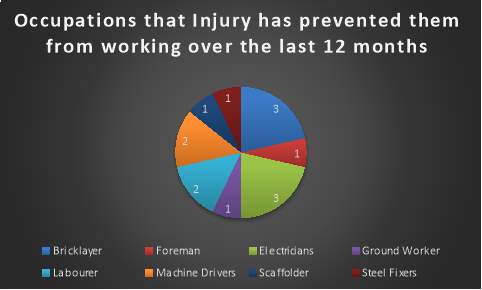
Figure 4
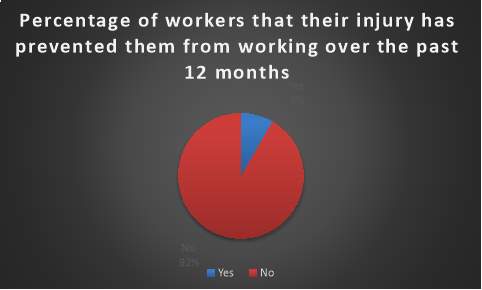
The pie charts above illustrates that 8% of people surveyed said injury has prevented them from working over the last 12 months. This part of the survey records 8 different back grounds with Bricklayers and Electricians recording the highest numbers at 3 each respectively.
Question No. 5
Do you think your work has caused or exacerbated the injury?
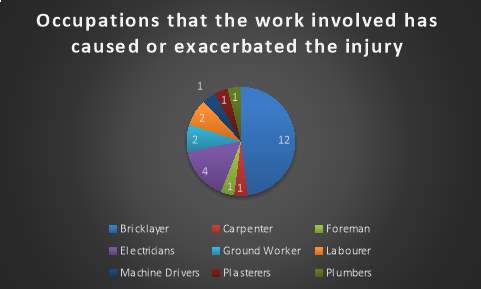
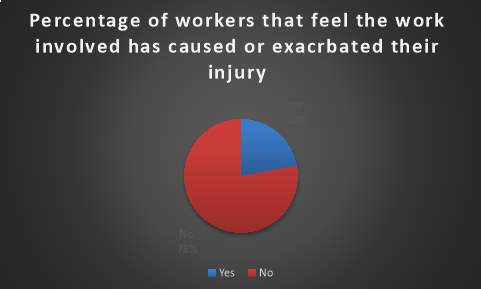
From the survey results, 22% of the people said injury that in their occupation had caused or exacerbated the injury. This part of the survey records 9 different back grounds with 12 Bricklayers recording the highest numbers almost 50% and 4 Electricians at 16% each, with the other occupations recording 1 and 2 respectively
To the best of your knowledge has your injury ever been reported to the Health and Safety Authority (HSA)?

Of the 76-people recorded in this survey only one individual identifying as a scaffolder has stated that his injury had been recorded with the Health and Safety Authority. In the comments sections he stated “operation with a plate fitted to my shoulder”
Question No. 7
Would you agree with the following statement construction work is physical intensive?

.
Of the 76-people recorded in this survey 53% believed their work to be physical intensive
Question No.8
Do you take any medication or pain relief for your symptoms related to your injury on a regular basis?
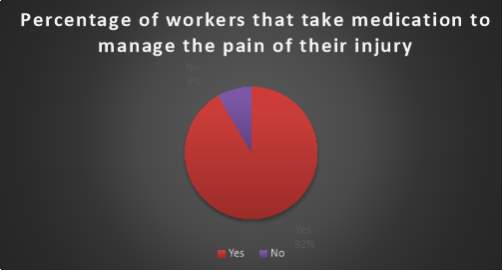
Of the 76-people recorded in this survey 8% of people took medication on a regular basis to manage the pain of the injury.
Question No. 9
Do you receive rehabilitation treatment for your injury example e.g. physiotherapy?
11% of workers surveyed receive medical treatment for their injury

Of the 76-people recorded in this survey 11% of people received rehabilitation on a regular basis to manage the injury, an example of physiotherapy was provided on the survey but no individual stated what treatment they received.
Question No. 10
Have you changed the way you work because of your injury?

Of the 76-people surveyed 17% have had to change the way they work due to their injury. No individual commented on what they do differently as a result of their injury.
Question No. 11
Do you believe your injury lead to any mental stress or anxiety now or in the past?
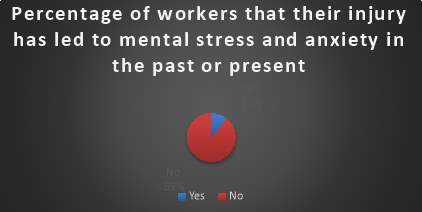
The survey of 76 workers reported that 11% believe their injury has led to mental stress or anxiety in the past or present. One Bricklayer commented that he was stressed “if I don’t work the bills don’t get paid. There is no sick pay here, I’m self-employed”.
Question No. 12
Do you warm up or stretch before any work tasks that involve manual handling?
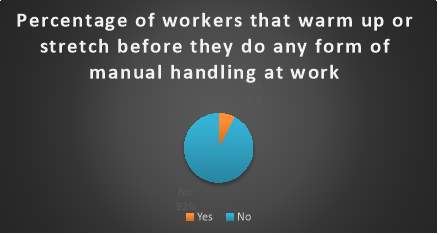
7.6% of workers surveyed stated they warm up or stretch before any work involving manual handling. No individual stated how they warmed up in the comments section.
Question No. 13
Do you take exercise in the form of sports activity or gym training, if so do you believe it helps with rehabilitation of your injury?
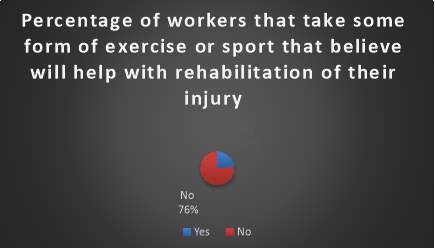
Of 76 people surveyed 24% of workers surveyed believed that sports activity or some form of training helped with rehabilitation of their injury. No individual stated what type of training they took in the comments section.
Question No. 14
Do you believe work tasks could be organised ergonomically better to reduce the risk of repetitive strain injury?
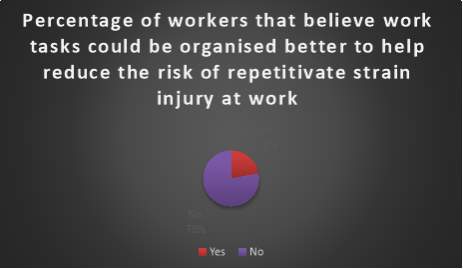
Figure 14
Of 76 people surveyed 22% of workers believed that work tasks can be organised better to reduce the risk of repetitive strain injury. No individual stated what type of training they took in the comments section.
Question No. 15
What is your opinion on the size and weight of materials you work with, could they be made lighter /easier to handle?
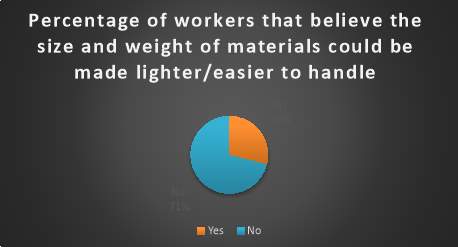
Of 76 people surveyed 29% of workers believed that materials could be made lighter and easier to handle. A scaffolder commented that; “20 kg should be the max to lift”, one electrician commented; “some cable reels are far too heavy” .
Interviews
This chapter analyses the data obtained from the opened interviews of tradesmen that have personal experience of Repetitive Strain Injury. The three men interviewed have all worked as bricklayers in the construction industry and would have a combined working experience of 95 years. Two of the men interviewed have been forced to retire early from work due to back issues. The third man still in the construction industry as a bricklayer.
To conduct a pertinent interview, it is important to do a trial interview to ensure questions are valid and that the questions asked during any interview are related to the research aim as laid out in chapter 1.
(Naoum, 2007)“The personal interview is another major technique for collecting information as well as opinions”
Through contacts with work colleagues in the construction industry contact was made with individuals graciously willing to give up their time, giving/given their experience with Repetitive Strain Injury. The questions posed were open ended to allow the interviewee to elaborate on their knowledge and experiences. This allowed for a more in-depth interview which in turn had a greater possibility of providing more valuable information than the survey. The purpose of this was to give validity ( greater or relevance) to the questions being asked. The author undertook three open ended interviews to aid with survey calculations and the literature review. These interviews proved to be an invaluable source of primary information. The author interviewed the following people:
- Interviewee a) Mr. Philip Hughes –Bricklayer, 8 Churchfield Lawns Skerries, Co. Dublin
- Interviewee b) Mr. Hugh Hamilton 21 Maplewood Way, Springfield, Tallaght, Dublin 24
- Interviewee c) Willie Murphy Bray Co Wicklow
- When did you first start work in construction
Interviewee a). “I started in 1974 that’s when I started my apprenticeship, first it was a 3-year apprenticeship in England at the time.”
Interviewee b) “I’m bricklaying since I was 20 and I was 48 when I had to stop, I started in 1976.”
Interviewee c) “I started in 1997, I started off as a labourer first, then started my bricklaying apprenticeship in 1998. “
This question was asked to gain the level of time and experience on site, all three men have a combined working experience of eighty-four years.
- What was your work day like?
Interviewee a) “it was very intense, when you were on price you get it up as quick as possible. “
Interviewee b) “it was go, go, go, as you got out of the car in the morning till packing up time.”
Interviewee c) “It’s a hard day’s work but every day is different you could be in footings one day and on brickwork the next, so some days are easier than others.”
This question was asked to get the view of the person regarding the level of the work intensity, the three-people interviewed are of the view that it is a physically demanding job.
- When did you first start noticing any pain or injuries.
Interviewee a) Claimed he first injured his back in 1981 after falling sixteen feet onto a 4-inch bar, and on the second occasion he recalled sitting down on scaffolding and could not get back up.
Interviewee b) Claimed within the first ten years of working he knew there was a problem with his back. Stating “When I’d finish my days work I’d sit down and it would take me a minute or two to straighten up when I’d get back up, there was pain there, most of the time”.
Interviewee c) Stated he was lifting a concrete beam before being warmed up properly stating “I got out of the car, it was a cold morning, went over to lift a concrete beam, at that point I felt something go in my back, that was in 2001”.
This question was asked to establish the first incident and to give a time frame from when they first started working in construction. All three-experienced injury from early on in their careers with an average time scale of seven years.
Interviewee a) Claimed that he has suffered from tennis elbow and had to alter the handle of the trowel, and suffered from a shoulder injury.
Interviewee b) Claimed that he suffers from a knee injury and believes it’s work related.
Interviewee c) Claimed he suffers from a shoulder problems and tennis elbow that have only affected him in recent times.
This question was asked to establish if the person has been affected with any other type of work related injury, interviewee a and b both experience shoulder issues, with c identifying knee problems.
- What is your opinion on the weight of materials you had to work with.
Interviewee a) Claimed when he first started working in Ireland he found it very hard to work with concrete blocks, and that six inch concrete blocks should be banded and stated “after the first week, I was nearly crying with the pain, the strain on the arm and back, the arms especially. We weren’t used to lifting the blocks, our bodies weren’t conditioned to lifting the blocks”.
Interviewee b) Claimed that concrete window sills are too heavy for one person to lift but often lifted and fitted window sills on his own and states “to fit a sill you had to fit it from the inside of the wall most of the time, when you had to get it into position you had to over stretch and let it over hang 3 or 4inches to get it into position”.
Interviewee c) Claimed he had to install window sills that measured over three meters long and that the only way of fitting them was manually and states “we were building a private house and the builder didn’t want to cut the windowsills so we had to lift them in by hand, they weighed a tonne, the forks couldn’t get past with all the scaffolding in the way
This question was posed to gain the opinion on the weight of building components related to their job. Interviewee b and c both commented on the weight of windowsills with interviewee a commenting on the weight of blocks.
- How do you think your job was organised in regards to avoiding injury?
Interviewee a) When asked the above question, interviewee a believes that scaffolding was not thought out properly and states that “once it’s away from the wall you’re in serious trouble because your lifting the block and arching over and putting serious strain on yourself” interviewee a, also said that footings are poorly organised stating “you’re in an area where there’s is not much room, you’re twisting and your lifting your whole side is going one way and you’d have to turn around. It’s not good when you’re carrying a two-stone block or even a three and half stone block. The widening of the foundations would be a good thing to give you enough room to do these things”.
Interviewee b) Believed that builders had little thought for workers and that scaffolding was poorly designed and stated, “I remember trying to do brickwork on my belly on a scaffolding and I asked the scaffolders to move it down and they wouldn’t. I had to lay the first five courses on my belly, I honestly don’t think it has improved that much”
Interviewee c) When asked the above question the interviewee believed that building sites in general are badly organised and states “I started with a sub-contractor a few weeks ago, he sent me and my mate over to do boundary walls, it had been started by someone else and not finished. We were expected to lift cavity blocks over steel reinforcement six-foot-high at every pier. We turned our backs and went home”.
This question was posed to establish the interviewees views on the organization of the work place. All three interviewees believe that the workplace is not properly organized, with both a and b stating that poorly erected scaffolding is an issue.Interviewee c described poorly thought out design.
- Do you believe that your occupation has contributed to your injury?
Interviewee a) Stated that bricklaying had a negative impact on his health, and states “the next step is an operation on my rotator cuff. It’s definitely related back to work without a shadow of a doubt”
Interviewee b) Believed his role as a bricklayer was the main reason for his back injury. Stating that “picking up, turning, bending, twisting and all that, was always a problem, bent over all day laying blocks it will catch up with you and all that.”
Interviewee c) Believed his role as a bricklayer is the main contributory factor in regards to his back injury and stated, “the last house I worked on, we had to lift concrete heads 3.3 meters long, they had to be lifted in by hand. As soon as I lifted the first one I could feel my back go, it’s that kind of lifting that does the damage I think”.
This question was posed to get the interviewees opinion on the causes of their injury. Both interviewee a and b required surgery for their injuries and considered their chosen occupation, as the main contributory factor. Interviewee c believed heavy lifting as the main problem.
Interviewee a) Stated that he was worried about undergoing another operation on his back. “I said I’m worried, it’s just not there and I’m worried it’ll go again if I did go back to work I reckon I would have an operation after 2 years instead of 5 years”.
Interviewee b) Said that it did have a mental strain on him and stated “It would have put mental strain on you, it would have put things into the back of your head, I was in my late twenties heading for my thirties I had no other trade”.
Interviewee c) Did not comment on this question
This question was posed to establish if RSI had any possible mental effects on the interviewees. Both interviewee a and b stated they had some mental anxiety because of RSI. Interviewee c did not comment on this.
- Did your injury impact on other parts of your life for example hobbies?
Interviewee a) Said he had to give up some hobbies, out of fear of agitating the injury and stated” I used to play tennis but can’t anymore, I did play golf but not anymore I’m scared stiff that I’ll swing the golf club the wrong way and I’d do damage”.
Interviewee b) Was not asked this question and didn’t not make any comments on the subject.
Interviewee c) Stated that he played football but gave it up but did not say it was directly related to RSI.
This question was posed to establish if RSI had any other impacts on other activities outside of work. Interviewee a stated he stopped playing golf and tennis out of fear of exacerbating the injury, he does continue to swim to aid recovery. Interviewee c gave up football but did not say it was as a result of RSI. Interviewee b was not asked the question due to time constraints.
- Before your injury were you aware of repetitive strain injury?
Interviewee a) Answered that he was aware of RSI at the time and stated, “I saw it before down in Newbridge on the Kodak factory, a Liverpudlian guy was in agony with his back that was in 1980, he had to go back home”.
Interviewee b) Said he was not aware of RSI but stated“I never heard of RSI back then, but within the first ten years I knew I was going to have trouble with my back”.
Interviewee c) Said he never heard of the term until recently.
This question was posed to establish the awareness of RSI among the people interviewed, with a having previous knowledge of RSI. Interviewees b and c had no previous knowledge of RSI.
- Did you ever warm up or stretch before work?
Interviewee a) Said he stretched before he started work and stated, “we were never advised to do any stretchingbut towards the later years I used to do a bit of stretching before I’d start”.
Interviewee b) Was not asked this question and made no comment in regards this
question.
Interviewee c) Said he would stretch on occasion before starting work
This question was posed to establish whether any preventative measures are taken to prevent injury. Interviewees a and c stretched in the later years before starting work. Interviewee b was not asked this question due to time constraints with the interview.
- Has your injury been reported to the Health and Safety Authority.
Interviewee a) Reported his injury to site management but did no state if it was reported to the HSA.
Interviewee b) Was reluctant to report his injury for fear of losing his job and stated. “If you mentioned an injury that time there was a danger they would have got someone else in to do the job”.
Interviewee c) Did not believe his injury has been reported to the HSA.
This question was posed to establish the level of reporting of RSI among the interviewees. a stated he reported the injury to management but it’s unclear if his injury had been reported to the HSA. Interviewee b and c did not report their injury to the HSA.
Chapter 5
Research Findings
Introduction
The purpose of this chapter is to evaluate the information obtained throughout this thesis, encompassing the primary and secondary sources of information provided in the form of interviews, questionnaires and the literature review. The literature review included government publications, reports, books, and web sites relating to RSI, while the questionnaire addressed many of the issues highlighted in the literature review.
The findings and recommendations arising from the literature review, questionnaire and interviews, will also be assessed as well as the concluding thoughts resulting from this research in line with the thesis objectives.
5.1 Research Goals
The main goal of this research was to explore the link between repetitive strain injury and the construction industry and the impact repetitive strain injury has on the individual and the ability to carry out work duties, this was assessed through a mixture of primary and secondary research. The main objectives of this thesis were as follows.
- To explore the link between repetitive strain injury and the construction industry.
- To identify the most prevalent types of repetitive strain injury in the construction industry.
- To identify the impact repetitive strain injury has on individuals and their ability to carry out work duties.
- To explore the awareness amongst construction workers of the condition and consider whether there should be more training made available to people.
- What preventative measures are taken to prevent RSI amongst the construction workforce.
Section 5.2 Findings
5.2.1 Repetitive Strain Injury in the Construction Industry.
From extensive research on literature relating to RSI the incidents of RSI in the construction industry is confirmed in various reports, including the (Health and Safety Executive, 2016) report. It states that people working in the construction industry, skilled tradesmen and machine operatives have statistically significantly greater rates of work related musculoskeletal disorders, with 920 cases per 100,000 workers. This is supported from both the survey questions and interviews conducted, and confirmed in question 1 of the survey.
Question 1 of the survey carried out confirmed the following most common RSI’s, lower back injury at 30%, shoulder injury at 16%, upper back and knees injuries at 14%. The third most common injuries include ankles/feet and neck at 7% This is then followed by hand/wrist at 6% and elbow at 5% respectively. This pattern of injury is also confirmed in Question 4 and 5 of the people interviewed with two people requiring corrective surgery because of injury sustained.
5.2.2 What are the most prevalent types of repetitive strain injury in the construction industry?
The prevalence of RSI is confirmed in the literature review with the recent (Health and Safety Authority , 2011) report of workplace injury recording Back at 22%, Shoulder 6%, Arm Injury 6%, Hand 8%, Fingers 10%, Leg 8%, and Ankle 6% respectively. This is also supported by the survey carried out and is illustrated in figure xxxxxx which confirms that the most prevalent RSI’s are the following, lower back injury at 30%, shoulder at 16%, upper back and knees at 14%. The third most common injuries include ankles/feet and neck at 7% This is then followed by hand/wrist at 6% and elbow at 5% respectively. It is evident that the back injury is the most common injury from the research conducted and the literature review.
Question 4 also supports this research, through the three interviews conducted, which highlight that back problems were their main injury issues, which resulted in two people needing early retirement due to corrective spinal surgery. Other problems stated included shoulder and knee injuries
5.2.3What impact repetitive strain injury has on the individual.
The research on literature relating to RSI, has established a link between the mental and emotional wellbeing of the person and the working environment. Back up Identified psychosocial factors (Hunting, et al., 1999) argues that construction workers claim that work related injuries have long term financial and emotional effects on the individuals and their families. (Schafeli & Maslach.C) found that employees who are stressed are inclined to withdraw psychologically from their work. This is also supported
Question 10 also supports this research, from the survey of 76 workers recorded 11% believe their injury has led to mental stress or anxiety in the past or present.
The interviews conducted also supports this research, with two interviewees expressing a level of anxiety in regards aggravating the injury and future employment prospects respectively.
5.2.4The awareness amongst construction workers of the condition and should there be more training made available to people.
5.2.5To investigate the level of under reporting of incidents to the Health and Safety Authority
The under reporting of incidents is supported through literature researched relating to the under-reporting accidents, (Health and Safety Executive) states that only 30% of reportable accidents were reported to the HSE. This is supported in question number 6 in the survey, which highlights that only one person out of seventy-six surveyed confirmed their injury had been reported to the HSA. The interviews also support this research, with one interviewees expressing they did not believe their injury was reported and one individual reluctant to report his injury to site management.
5.2.6What preventative measures are taken to prevent RSI amongst the construction workforce
The literature researched found that good ergonomics in the can help in the reducing the risk of RSI (National Institute for Occupational Safety and Health, 2007). Another report carried out by the (Health and Safety Executive) finds that financial issues may influence managers not to spend money on good ergonomics especially if they judge that there will be little financial benefit. This is backed up in both the questionnaire and interviews interviewee a and b believes that scaffolding was not thought out properly, with interviewee c believing that construction sites are not thought out properly. And of 76 people surveyed 22% of workers believed that work tasks could be organised.
Chapter 6 – Conclusion and Recommendations
Chapter 6 Introduction
The purpose of this chapter is to arrive at a conclusion from the main findings conducted in this thesis. The chapter together the conclusions from the data provided throughout the dissertation. Each objective is examined and a main conclusion is presented. The chapter finishes with proposals for further research opportunities on this topic.
Chapter 6 – Conclusion
The objectives of this thesis were to determine the relationship with which RSI in the construction industry, and common symptoms experienced among the workforce. The main findings of this thesis confirm that the experience of RSI among the Irish construction work force, is comparable with international studies carried out. The information obtained during the literature review confirms that internationally, RSI is a common form of work-related ill-health. The Literature also indicates that job stress plays a role in the emergence of psychosocial issues with the resulting negative effects this has on the individual. This research is supported through the interviews and the survey conducted in this study, with interviewees highlighting the financial impact through the loss of earnings due to time lost at work and expensive medical treatments required to manage the symptoms.
There is also impact of and poor ergonomic factors in the work place and its relationship with RSI. The three-people interviewed expressed various issues they have experienced on construction sites. Expressing their experiences of poorly designed and thought out scaffolding systems and ill thought out building designs work. This is also backed up in the survey conducted, with 22% of workers surveyed believing that work tasks could be better organised. Good work practices are also in the interest of the employer, with poor management of the workplace, employers expose themselves to legal action and expensive compensation claims and negative press coverage.
Research Limitations
Semi structured interviews were conducted in the making of this thesis this required good interviewing skills that the author had previously no experience with. Contacts within the construction industry allowed author to gain access to credible interviewees, time constraints on with both parties made plans difficult confirm. One interview was conducted face to face, and to accommodate the second and third interviewees, phone interviews were conducted.
To conduct the survey the author contacted work colleagues to establish suitable times to conduct the survey, the surveys were completed on the paricipatants free time Conducting the survey
Cite This Work
To export a reference to this article please select a referencing stye below:
Related Services
View allRelated Content
All TagsContent relating to: "Medical"
The word Medical refers to preventing or treating injuries or illnesses, relating to the study or practice of medicine. Medical care involves caring for a patient and helping them through their journey to recovery.
Related Articles
DMCA / Removal Request
If you are the original writer of this dissertation and no longer wish to have your work published on the UKDiss.com website then please:

